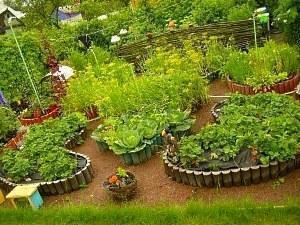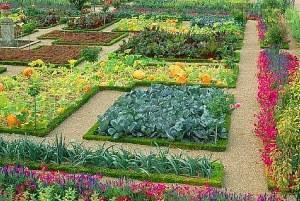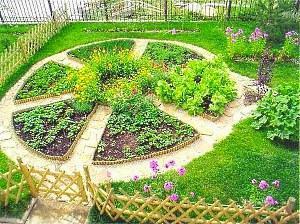The French garden will turn your plot into a fabulous getaway
 Recently, the French kitchen garden, made by hand, has begun to gain particular popularity. Such a garden will bring an original zest to your site.
Recently, the French kitchen garden, made by hand, has begun to gain particular popularity. Such a garden will bring an original zest to your site.
How is the French vegetable garden different from the usual?
The French vegetable garden is based on the traditions of the gardens of the time of Louis XIV. It symbolizes harmony, beauty, purity and order.
The main feature of the French garden is the presence of symmetrical elements and geometric shapes. By tradition, it is a rectangle that is divided into 4 identical squares. A sculpture and a sundial are placed in the center of the rectangle.
The French vegetable garden stands out for its decorativeness: not only vegetables grow on beautifully decorated flower beds, but also flowers, shrubs and fruit trees. Beautifully designed tile paths are located between the flower beds.
We are planning a French garden

Garden beds in a French garden can:
- be at the same level as the entire site;
- rise 20-30 centimeters from the ground. In this case, their walls are made of stone, brick or other material. To create such beds, you will have to make additional efforts, but the work spent will pay off: the beds will acquire an original and attractive look, and it will be easier to care for them.
The next step is to identify the plants to be planted in the beds. Bare earth should not be found in the French garden: vegetables organically replace each other, and empty spaces are filled with ornamental plants. When arranging the beds, it is necessary to place the plants so that they do not interfere with each other. In this case, one should take into account the photophilousness of plants, their height, the period of flowering and fruiting.
Vertical accents are an obligatory attribute of the French garden:
- temporary - walls decorated with corn, tomatoes, legumes, curly decorative annuals;
- permanent - made with berry or ornamental shrubs, climbing perennials, small apple trees.
We make out a French garden with our own hands
 First, draw a geometric shape on the site, the shape of which your flower bed will take. Draw rays from the center of the figure - you will have triangular beds. Divide the sectors with decorative paths or a lawn. To prevent the earth from crumbling, beautifully lay stones, bricks or wooden boards around each garden bed, install a decorative fence. Ornamental cabbage, red lettuce, or marigolds can be planted around the beds. They will decorate the flower bed, and marigolds will also protect the inhabitants of the garden from pests.
First, draw a geometric shape on the site, the shape of which your flower bed will take. Draw rays from the center of the figure - you will have triangular beds. Divide the sectors with decorative paths or a lawn. To prevent the earth from crumbling, beautifully lay stones, bricks or wooden boards around each garden bed, install a decorative fence. Ornamental cabbage, red lettuce, or marigolds can be planted around the beds. They will decorate the flower bed, and marigolds will also protect the inhabitants of the garden from pests.
When the beds are ready, you can start planting plants. To give the flower beds a variety of colors, it is recommended to plant a variety of leafy lettuce, ornamental cabbage, fragrant basil, nasturtium, calendula, marigolds, snapdragons, asters and other bright plants. Fruit trees and shrubs can be planted around the garden. They will decorate the site and protect the plants from cold winds.
Preparation stages
Let's summarize. To arrange a French garden you need:
- Change the shape of the beds.
- Highlight the garden bed visually.
- Surround the garden with a border or decorative fence.
- Plant the plants.
With the help of a French vegetable garden, you will turn your plot into a recreation area. If desired, near the flower bed, you can place a pergola with clematis or climbing roses, decorative ampelous plants, sculptures, lanterns.
A do-it-yourself French garden will cause the envy and admiration of all neighbors and attract the glances of passers-by. And it will allow you to relax on a summer evening after a busy day and enjoy the results of your labor.